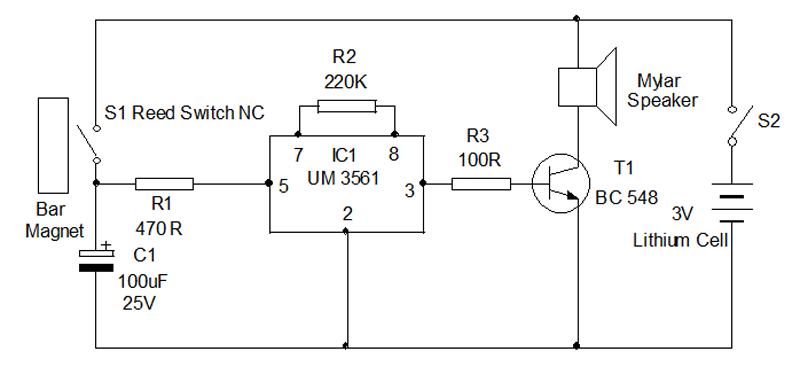
Infrared Detector Circuit with PID20

This infrared detector circuit utilizes a passive infrared detector component, PID20, which converts heat radiation into electrical impulses. The output voltage of the PID20 increases when an object approaches, provided that the object is warmer than the surrounding environment. The voltage variations at the output of the IR sensor are detected by the comparators IC2a and IC2b. Once the sensor identifies an object (regardless of the object's actual temperature), one of the comparators activates the transistor T1, which subsequently closes the connected relay. It is possible to use a separate transistor for each comparator, enabling the sensor to distinguish whether the object is warmer or cooler than the surroundings. The IR detector circuit operates with a current consumption of approximately 1 mA, while the sensor itself consumes about 0.2 mA.
The infrared detector circuit is designed for applications that require the detection of heat-emitting objects within a specified range. The PID20 component is sensitive to infrared radiation emitted by objects, allowing it to detect variations in heat signatures. This feature makes it suitable for security systems, automatic lighting controls, and occupancy sensing applications.
The output from the PID20 is fed into two operational amplifiers configured as comparators (IC2a and IC2b). These comparators are set with reference voltages that define the thresholds for detection. When the output voltage from the PID20 exceeds the reference voltage of either comparator, it triggers the corresponding output. This output can be used to drive a transistor, such as T1, which acts as a switch to control a relay. The relay can then activate or deactivate connected devices, such as alarms or lights, based on the detection of an object.
The circuit's design can be enhanced by incorporating hysteresis into the comparator configuration, which helps to prevent false triggering due to noise or minor fluctuations in temperature. Additionally, using separate transistors for each comparator allows for more complex logic operations, enabling the circuit to differentiate between objects that are warmer or cooler than the ambient temperature. This capability can be particularly useful in applications where precise temperature differentiation is necessary.
Overall, the infrared detector circuit provides a reliable means of detecting heat sources, with low power consumption making it suitable for battery-operated devices. The straightforward design allows for easy integration into various electronic systems, enhancing their functionality and responsiveness to environmental changes.This infrared detector circuit uses a passive IR-detector component PID20. It converts heat radiation into electrical impulses. The output voltage of the PID20 increases when an object comes close to it, this object must be warmer than the surroundings. The voltage changes at the output of the IR sensor are sensed by the comparators IC2a and IC2b. Once the sensor detects an object (independent of the object`s actual temperature), one of the comparators will turn on the transistor T1. This transistor then closes the relay connected to it. A separate transistor for each comparator can be used so that the sensor will be able to determine whether the object is warmer or colder than the surroundings.
The IR detector circuit consumes around 1 mA and the sensor consumes 0. 2 mA. 🔗 External reference
The infrared detector circuit is designed for applications that require the detection of heat-emitting objects within a specified range. The PID20 component is sensitive to infrared radiation emitted by objects, allowing it to detect variations in heat signatures. This feature makes it suitable for security systems, automatic lighting controls, and occupancy sensing applications.
The output from the PID20 is fed into two operational amplifiers configured as comparators (IC2a and IC2b). These comparators are set with reference voltages that define the thresholds for detection. When the output voltage from the PID20 exceeds the reference voltage of either comparator, it triggers the corresponding output. This output can be used to drive a transistor, such as T1, which acts as a switch to control a relay. The relay can then activate or deactivate connected devices, such as alarms or lights, based on the detection of an object.
The circuit's design can be enhanced by incorporating hysteresis into the comparator configuration, which helps to prevent false triggering due to noise or minor fluctuations in temperature. Additionally, using separate transistors for each comparator allows for more complex logic operations, enabling the circuit to differentiate between objects that are warmer or cooler than the ambient temperature. This capability can be particularly useful in applications where precise temperature differentiation is necessary.
Overall, the infrared detector circuit provides a reliable means of detecting heat sources, with low power consumption making it suitable for battery-operated devices. The straightforward design allows for easy integration into various electronic systems, enhancing their functionality and responsiveness to environmental changes.This infrared detector circuit uses a passive IR-detector component PID20. It converts heat radiation into electrical impulses. The output voltage of the PID20 increases when an object comes close to it, this object must be warmer than the surroundings. The voltage changes at the output of the IR sensor are sensed by the comparators IC2a and IC2b. Once the sensor detects an object (independent of the object`s actual temperature), one of the comparators will turn on the transistor T1. This transistor then closes the relay connected to it. A separate transistor for each comparator can be used so that the sensor will be able to determine whether the object is warmer or colder than the surroundings.
The IR detector circuit consumes around 1 mA and the sensor consumes 0. 2 mA. 🔗 External reference





